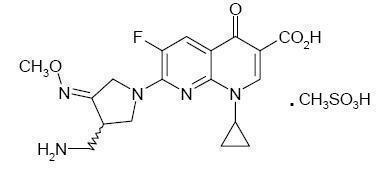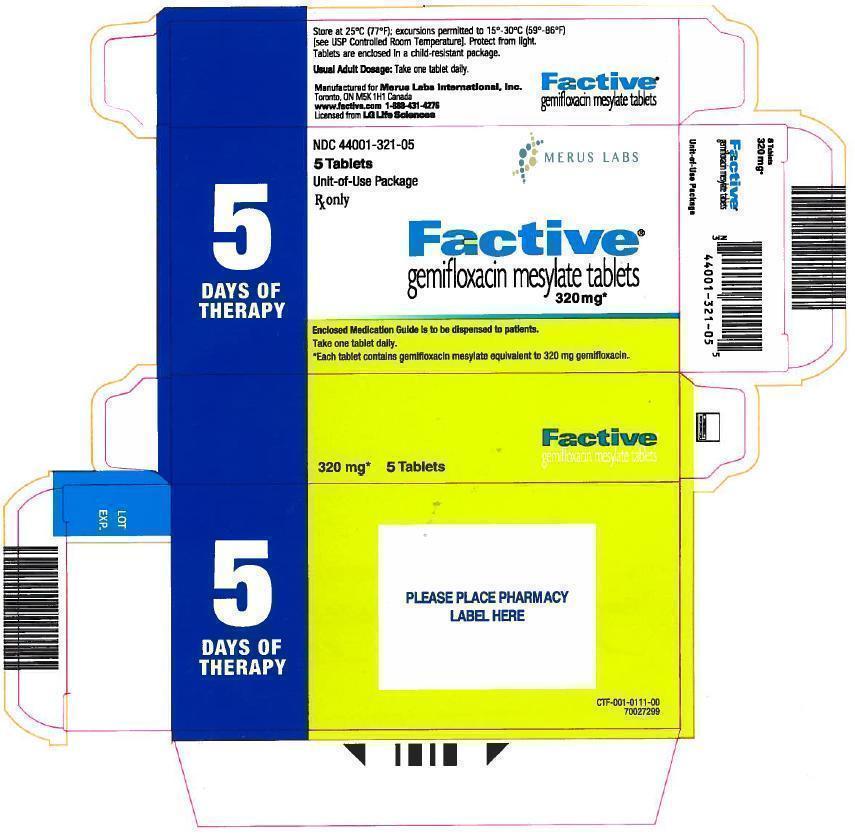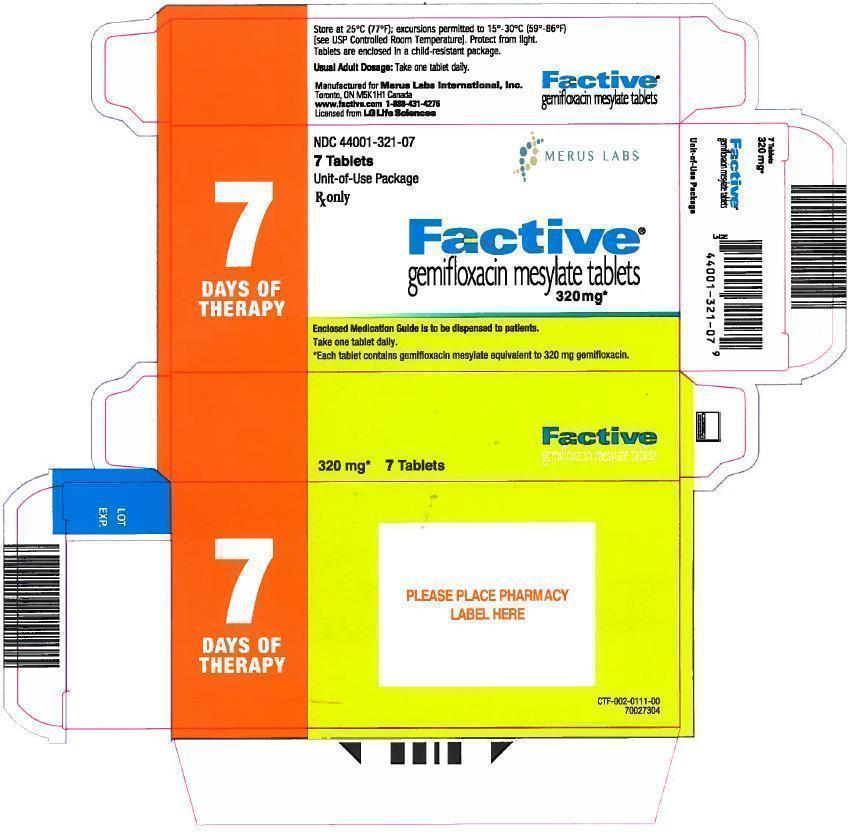Factive
Generic name: gemifloxacin
Drug class: Quinolones
Medically reviewed by A Ras MD.
What is Factive?
It is not known if Factive is safe and effective in children under 18 years of age. Children have a higher chance of getting bone, joint, or tendon (musculoskeletal) problems such as pain or swelling while taking fluoroquinolone antibiotic medicines.
Sometimes infections are caused by viruses rather than by bacteria. Examples include viral infections in the sinuses and lungs, such as the common cold or flu. Antibiotic medicines including Factive do not kill viruses.
Call your healthcare provider if you think your condition is not getting better while you are taking Factive.
Description
FACTIVE (gemifloxacin mesylate) is a synthetic broad-spectrum antibacterial agent for oral administration. Gemifloxacin, a compound related to the fluoroquinolone class of antibiotics, is available as the mesylate salt in the sesquihydrate form. Chemically, gemifloxacin is (R,S)-7-[(4Z)-3-(aminomethyl)-4-(methoxyimino)-1-pyrrolidinyl]-1-cyclopropyl-6-fluoro-1,4-dihydro-4-oxo-1,8-naphthyridine-3-carboxylic acid.
The mesylate salt is a white to light brown solid with a molecular weight of 485.49. Gemifloxacin is considered freely soluble at neutral pH (350 μg/mL at 37ºC, pH 7.0). Its empirical formula is C18H20FN5O4•CH4O3S and its chemical structure is:

Each white to off-white, oval, film-coated FACTIVE tablet has breaklines and GE 320 debossed on both faces and contains gemifloxacin mesylate equivalent to 320 mg gemifloxacin. The inactive ingredients are crospovidone, hydroxypropyl methylcellulose, magnesium stearate, microcrystalline cellulose, polyethylene glycol, povidone, and titanium dioxide.
What is the most important information I should know about Factive?
Factive, a fluoroquinolone antibiotic medicine, can cause serious side effects. Some of these serious side effects can happen at the same time and could result in death.
If you get any of the following serious side effects while you are taking Factive, you should stop taking Factive immediately and get medical help right away.
1. Tendon rupture or swelling of the tendon (tendinitis). Tendon problems can happen in people of all ages who take Factive. Tendons are tough cords of tissue that connect muscles to bones. Symptoms of tendon problems may include: pain, swelling, tears, and inflammation of tendons including the back of the ankle (Achilles), shoulder, hand, or other tendon sites.
- The risk of getting tendon problems while you take Factive is higher if you:
- are over 60 years of age
- are taking steroids (corticosteroids)
- have had a kidney, heart, or lung transplant
Tendon problems can happen in people who do not have the above risk factors when they take Factive.
- Other reasons that can increase your risk of tendon problems can include:
- physical activity or exercise
- kidney failure
- tendon problems in the past, such as in people with rheumatoid arthritis (RA)
- Stop taking Factive immediately and get medical help right away at the first sign of tendon pain, swelling or inflammation. Stop taking Factive until tendinitis or tendon rupture has been ruled out by your healthcare provider. Avoid exercise and using the affected area. The most common area of pain and swelling is the Achilles tendon at the back of your ankle. This can also happen with other tendons.
- Talk to your healthcare provider about the risk of tendon rupture with continued use of Factive. You may need a different antibiotic medicine that is not a fluoroquinolone to treat your infection.
- Tendon rupture can happen while you are taking or after you have finished taking Factive. Tendon ruptures can happen within hours or days of taking Factive and have happened up to several months after patients have finished taking their fluoroquinolone.
- Get medical help right away if you get any of the following signs or symptoms of a tendon rupture:
- hear or feel a snap or pop in a tendon area
- bruising right after an injury in a tendon area
- unable to move the affected area or put weight on the affected area
2. Changes in sensation and possible nerve damage (Peripheral Neuropathy). Damage to the nerves in arms, hands, legs, or feet can happen in people taking fluoroquinolones, including Factive. Stop taking Factive and call your healthcare provider right away if you get any of the following symptoms of peripheral neuropathy in your arms, hands, legs, or feet:
- pain
- burning
- tingling
- numbness
- weakness
The nerve damage may be permanent.
3. Central Nervous System (CNS) effects. Seizures have been reported in people who take fluoroquinolone antibiotic medicines, including Factive. Tell your healthcare provider if you have a history of seizures. Ask your healthcare provider whether taking Factive will change your risk of having a seizure. CNS side effects may happen as soon as after taking the first dose of Factive. Call your healthcare provider right away if you get any of these side effects, or other changes in mood or behavior:
- feel dizzy
- seizures
- hear voices, see things, or sense things that are not there (hallucinations)
- feel restless
- tremors
- feel anxious or nervous
- confusion
- depression
- trouble sleeping
- feel more suspicious (paranoia)
- suicidal thoughts or acts
- nightmares
- feeling lightheaded
4. Worsening of myasthenia gravis (a disease which causes muscle weakness). Fluoroquinolones like Factive may cause worsening of myasthenia gravis symptoms, including muscle weakness and breathing problems. Tell your healthcare provider if you have a history of myasthenia gravis before you start taking Factive. Call your healthcare provider right away if you have any worsening muscle weakness or breathing problems.
See the section “What are the possible side effects of Factive?” for more information about side effects.
Who should not take Factive?
Do not take Factive if you have ever had a severe allergic reaction to an antibiotic known as a fluoroquinolone, or are allergic to any of the ingredients in Factive. Ask your healthcare provider if you are not sure. See the list of ingredients in Factive at the end of this Medication Guide.
What should I tell my healthcare provider before taking Factive?
See “What is the most important information I should know about Factive?”
Before taking Factive, tell your healthcare provider about all your medical conditions, including if you:
- have tendon problems. Factive should not be used in patients who have a history of tendon problems.
- have a disease that causes muscle weakness (myasthenia gravis). Factive should not be used in patients who have a known history of myasthenia gravis.
- have CNS problems (such as epilepsy).
- have nerve problems. Factive should not be used in patients who have a history of nerve problems called peripheral neuropathy.
- have or have anyone in your family who has an irregular heartbeat, especially a condition called “QT prolongation”.
- have low blood potassium (hypokalemia) or low magnesium (hypomagnesemia).
- have a slow heart beat (bradycardia).
- have a history of seizures.
- have kidney problems. You may need a lower dose of Factive if your kidneys do not work well.
- have rheumatoid arthritis (RA) or history of other joint problems.
- are pregnant or planning to become pregnant. It is not known if Factive will harm your unborn child.
- are breastfeeding or planning to breastfeed. It is not known if Factive passes into breast milk. You and your healthcare provider should decide whether you will take Factive or breastfeed.
Tell your healthcare provider about all the medicines you take, including prescription and over-the-counter medicines, vitamins, and herbal and dietary supplements. Factive and other medicines can affect each other causing side effects.
Especially tell your healthcare provider if you take:
- a Non-Steroidal Anti-Inflammatory Drug (NSAID). Many common medicines for pain relief are NSAIDs. Taking an NSAID while you take Factive or other fluoroquinolones may increase your risk of CNS effects and seizures. See “What is the most important information I should know about Factive?”
- a blood thinner (warfarin, Coumadin, Jantoven).
- a medicine to control your heart rate or rhythm (antiarrhythmics). See “What are the possible side effects of Factive?”
- an anti-psychotic medicine.
- a tricyclic antidepressant.
- a water pill (diuretic).
- probenecid (Probalan, Col-Probenecid).
- a steroid medicine. Corticosteroids taken by mouth or by injection may increase the chance of tendon injury. See “What is the most important information I should know about Factive?”
Certain medicines may keep Factive from working correctly. Take Factive at least 3 hours before or 2 hours after taking these products:
- an antacid, multivitamin, or other product that contains magnesium, aluminum, iron, or zinc
- sucralfate (Carafate)
- didanosine (Videx, Videx EC)
Ask your healthcare provider if you are not sure if any of your medicines are listed above.
Know the medicines you take. Keep a list of your medicines and show it to your healthcare provider and pharmacist when you get a new medicine.
How should I take Factive?
- Take Factive exactly as prescribed by your healthcare provider.
- Factive tablets should be swallowed.
- Factive can be taken with or without food.
- Drink plenty of fluids while taking Factive.
- Do not skip any doses, or stop taking Factive even if you begin to feel better, until you finish your prescribed treatment, unless:
- you have tendon effects (see “What is the most important information I should know about Factive?”),
- you have nerve problems (see “What is the most important information I should know about Factive?”),
- you have CNS problems (see “What is the most important information I should know about Factive?”),
- you have a serious allergic reaction (see “What are the possible side effects of Factive?”), or your healthcare provider tells you to stop.
This will help make sure that all of the bacteria are killed and lower the chance that the bacteria will become resistant to Factive. If this happens, Factive and other antibiotic medicines may not work in the future.
- If you take too much Factive, call your healthcare provider or get medical help immediately.
What should I avoid while taking Factive?
- Factive can make you feel dizzy and lightheaded. Do not drive, operate machinery, or do other activities that require mental alertness or coordination until you know how Factive affects you.
- Avoid sunlamps, tanning beds, and try to limit your time in the sun. Factive can make your skin sensitive to the sun (photosensitivity) and the light from sunlamps and tanning beds. You could get severe sunburn, blisters or swelling of your skin. If you get any of these symptoms while taking Factive, call your healthcare provider right away. You should use sunscreen and wear a hat and clothes that cover your skin if you have to be in sunlight.
What are the possible side effects of Factive?
Factive may cause serious side effects, including:
- See “What is the most important information I should know about Factive?”
- Serious allergic reactions. Allergic reactions can happen in people taking fluoroquinolones, including Factive, even after only 1 dose. Stop taking Factive and get emergency medical help right away if you get any of the following symptoms of a severe allergic reaction:
- hives
- trouble breathing or swallowing
- swelling of the lips, tongue, face
- throat tightness, hoarseness
- rapid heartbeat
- faint
- yellowing of the skin or eyes. Stop taking Factive and tell your healthcare provider right away if you get yellowing of your skin or white part of your eyes, or if you have dark urine. These can be signs of a serious reaction to Factive (a liver problem).
- Skin rash may also happen in people taking Factive. Stop taking Factive at the first sign of a skin rash and call your healthcare provider. Skin rash may be a sign of a more serious reaction to Factive. Rash happens more often with Factive in:
- women, especially women who take hormone replacement therapy
- people under 40 years of age
- people who take Factive for longer than 5 days
- Clostridium difficile-associated diarrhea (CDAD). CDAD is an infection of your intestines (bowels) that can happen with many antibiotic medicines like Factive and may cause mild diarrhea to life-threatening swelling of your intestines (colitis). Call your healthcare provider right away if you get stomach cramps, fever, watery diarrhea, diarrhea that does not go away, or bloody stools. CDAD can happen 2 or more months after you have finished your antibiotic medicine.
- Serious heart rhythm changes (QT prolongation and torsades de pointes). Tell your healthcare provider right away if you have a change in your heartbeat (a fast or irregular heartbeat), or if you faint. Factive may cause a rare heart problem known as prolongation of the QT interval. This condition can cause an abnormal heartbeat and can be very dangerous. The chances of this happening are higher in people:
- who are elderly
- with a family history of prolonged QT interval
- with low blood potassium (hypokalemia) or low magnesium (hypomagnesemia)
- who take certain medicines to control heart rhythm (antiarrhythmics)
- Changes in blood sugar
People who take fluoroquinolone medicines with oral anti-diabetes medicines or with insulin can get low blood sugar (hypoglycemia) and high blood sugar (hyperglycemia). Follow your healthcare provider’s instructions for how often to check your blood sugar. If you have diabetes and you get low blood sugar while taking Factive, stop taking Factive and call your healthcare provider right away. Your antibiotic medicine may need to be changed. - Aortic aneurysm and dissection
Tell your healthcare provider if you have ever been told that you have an aortic aneurysm, a swelling of the large artery that carries blood from the heart to the body. Get emergency medical help right away if you have sudden chest, stomach, or back pain.Sensitivity to sunlight (photosensitivity). See “What should I avoid while taking Factive?”
The most common side effects of Factive include:
- diarrhea
- rash
- nausea
- stomach pain
- headache
These are not all the possible side effects of Factive. Tell your healthcare provider about any side effect that bothers you or that does not go away.
Call your doctor for medical advice about side effects. You may report side effects to FDA at 1-800-FDA-1088.
General information about the safe and effective use of Factive
Medicines are sometimes prescribed for purposes other than those listed in a Medication Guide. Do not use Factive for a condition for which it is not prescribed. Do not give Factive to other people, even if they have the same symptoms that you have. It may harm them.
This Medication Guide summarizes the most important information about Factive. If you would like more information about Factive, talk with your healthcare provider. You can ask your healthcare provider or pharmacist for information about Factive that is written for healthcare professionals.
How should I store Factive?
- Store Factive at room temperature between 59º – 86ºF (15º to 30ºC).
- Keep Factive away from light.
Keep Factive and all medicines out of the reach of children.
What are the ingredients in Factive?
- Active ingredient: gemifloxacin
- Inactive ingredients: crospovidone, hydroxypropyl methycellulose, magnesium stearate, microcrystalline cellulose, polyethylene glycol, povidone, titanium dioxide.
Label
PRINCIPAL DISPLAY PANEL

Factive 5 Tablets

Factive 7 Tablets
SRC: NLM .
